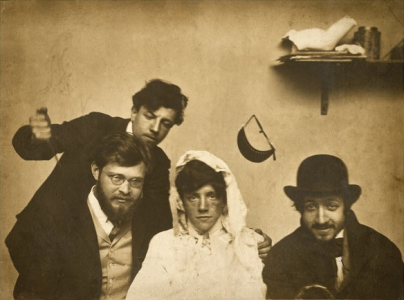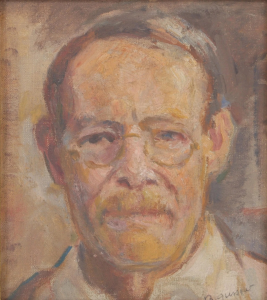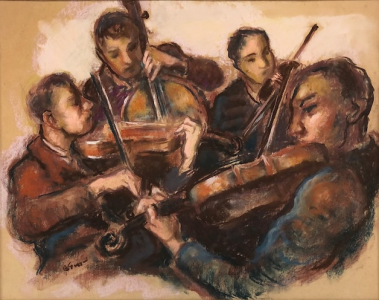

Biography
Gussow was born in Minsk, Russia in 1881, the son of Rabbi Mordecai Gussow and XYZ. He was brought to the United States in 1980, where he studied at City College of New York, the Art Students League, and the National Academy of Design. He did additional work with the master portrait artist Leon Bonnat at the Ecole des Beaux-Arts in Paris.
Back in the New York, Gussow married Susanne Jeanette Cook, a Canadian three years his senior. According to the Ancestry website, the couple had two children - James Kinnear Gussow (b.1911) and Delmor K. Gussow (b.1912). Bernard took a job teaching at the New Jersey School of Fine and Industrial Art in Newark, which he held from 1910-1955, shortly before his death.
Meanwhile his art career advanced. He had two pieces in the Armory Show in 1913, and he exhibited at the Society of Independent Artists from 1917-1934. His work was selected to be shown at the Luxembourg Museum in Paris in 1919, but in a very controversial decision the French authorities declined to hang the works of eight modernist painters. Gussow was a founder of Modern Artists in America in 1922 and participated in their first exhibit at the Joseph Brummer Galleries in New York.
In the 1930s Gussow's work was exhibited at the Salons of America, which had held annual exhibitions since 1922. He was employed by a WPA project known as the Index of American Design. This project ran from 1936-1942 and employed over 1,000 artists to create drawings and watercolors that depicted craft objects from the American past. The examples of Gussow's contributions to this project involve some exquisitely painted watercolors.
Gussow was a founder of Modern Artists in America and, after exhibiting with the Society of Independent Artists for many years, he became one of the Society's directors. Gussow completed one Post Office mural - for East Rochester, NY in 1938. And he provided watercolors to help decorate the U.S. Marine Hospital in Carville, Louisiana in 1941. Gussow died in New York City in 1957.



Critical Analysis
Among the simplest measures of postumous fame in today's world is the length of one's page in Wikipedia. Astonishingly, Bernard Gussow has no such page, even though dozens of his paintings can still be found for sale. And these tend to be excellent works of art - unless you are put off by his slightly gauzy style of representation. Gussow definitely deserves a better reputation than the art world seems to have given him.
There were three major focuses for Gussow's work. The first two involved genre paintings - exterior and interior. Gussow's outdoor scenes often focused on New York's subway and its patrons. He had an uncanny ability to capture the feel of subway cars, subway platforms, and the stair and corridors inside of subway stations. He must have liked the scenes of packed humanity that were often scene in this environment, and he ably conveyed the feel of these scenes in his paintings.
His style was comfortably that of the Ash Can school. The faces of his subjects were often indistinct, perhaps a nod to the Blue Rider Group and the German Expressionists or a way of indicating the anonymity of encounters in the subway. His compositions were invariably lively and compelling. A viewer can almost feel the press of bodies in a subway car and smell the scent of commuters packed onto a Friday afternoon train.
The second subject, present in many Gussow interiors, was music. Gussow showed musicians at work and audiences enjoying the result of this work. The intimate feel of these many paintings suggest that someone close to Gussow - perhaps his wife or another close relative - was a professional musician, since the paintings convey not just the enjoyable that a listener might feel but also the effort and concentration that goes into the production of fine music.
The third aspect of Gussow's work is revealed in his many watercolors for the Index of American Design. Looking at these paintings, it's hard to believe that they are watercolors and not expertly-lit photographic illustrations. The skill with which Gussow rendered this work is almost uncanny, especially since the whole Index project was primarily a way of providing income to a large number of artists across the country. Gussow clearly took his assignment seriously and applied a standard of personal perfection to each painting he produced for the Index.
Murals
- East Rochester, New York - Post Office: Recreation Hours
References
- Bernard Gussow (askART).
- Bernard Gussow (Papillon Gallery).
- Bernard Gussow (Artnet).
- Bernard Gussow (1881 – 1957) (Helicline Fine Art).
- Bernard Gussow, Artist, 76, Dead; Modern Realist Did Portraits, Murals and Lithographs-- Newark Teacher 45 Years, The New York Times February 10 (1957).
- A midcentury artist captures the anonymity of the subway in 5 paintings, Ephemeral New York March 27 (2023).